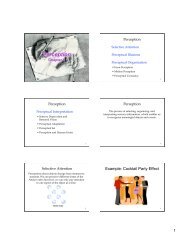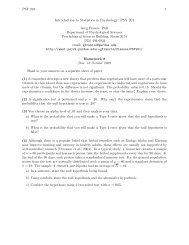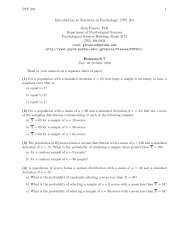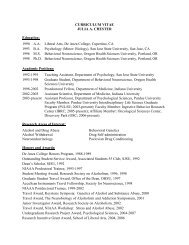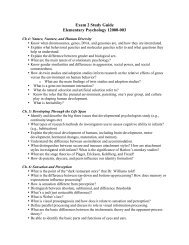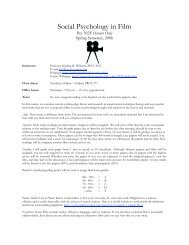Maxims or Myths of Beauty? A Meta-Analytic and Theoretical Review
Maxims or Myths of Beauty? A Meta-Analytic and Theoretical Review
Maxims or Myths of Beauty? A Meta-Analytic and Theoretical Review
Create successful ePaper yourself
Turn your PDF publications into a flip-book with our unique Google optimized e-Paper software.
(Spears, 1993, p. 45) <strong>and</strong>, theref<strong>or</strong>e, do not agree about who is <strong>and</strong><br />
is not attractive. Although this maxim is invoked both within <strong>and</strong><br />
between cultures, it is believed to be true especially between<br />
cultures because different cultures presumably have very dissim-<br />
ilar st<strong>and</strong>ards <strong>of</strong> beauty (see, e.g., Darwin, 1871; F<strong>or</strong>d & Beach,<br />
1951). Assessing the veracity <strong>of</strong> this maxim is imp<strong>or</strong>tant because<br />
without consensus in judgments <strong>of</strong> attractiveness, there can be no<br />
consistent effect <strong>of</strong> attractiveness on social judgments, interac-<br />
tions, <strong>or</strong> behavi<strong>or</strong>. Empirically, if beauty is only in the eye <strong>of</strong> the<br />
beholder, judgments <strong>of</strong> attractiveness should show little consis-<br />
tency among raters <strong>and</strong>, thus, low reliability coefficients. Only one<br />
meta-analysis we know <strong>of</strong> has quantitatively evaluated the reli-<br />
ability coefficients <strong>of</strong> attractiveness judgments. Feingold (1992a)<br />
examined panels <strong>of</strong> raters from within the United States <strong>and</strong><br />
Canada <strong>and</strong> found a high level <strong>of</strong> agreement among adult raters.<br />
However, we do not know <strong>of</strong> any meta-analysis that has examined<br />
reliability coefficients <strong>of</strong> attractiveness judgments made by <strong>or</strong><br />
about children n<strong>or</strong> do we know <strong>of</strong> any meta-analysis investigating<br />
agreement across raters <strong>of</strong> different ethnicities <strong>and</strong> cultures.<br />
Never Judge a Book by Its Cover<br />
Judge not acc<strong>or</strong>ding to the appearance.--John 7:24<br />
Wilkinson (1993) defined this maxim as meaning "do not judge<br />
by externals" (p. 407). The maxim urges people to disregard<br />
external appearance <strong>and</strong> to judge <strong>and</strong> treat others only on the basis<br />
<strong>of</strong> the "contents <strong>of</strong> the book." Research has yet to determine<br />
whether this maxim accurately reflects judgments <strong>and</strong> treatment <strong>of</strong><br />
others in actual interactions <strong>or</strong> whether the maxim represents an<br />
ideal. To determine if there is adherence to this maxim, we divided<br />
<strong>and</strong> operationalized it into two components: (a) Judgments <strong>of</strong><br />
others should not be based on their appearance, <strong>and</strong> (b) treatment<br />
<strong>of</strong> others should not be based on their appearance. If people<br />
conf<strong>or</strong>m to the maxim, then meta-analysis should find no signif-<br />
icant effects <strong>of</strong> attractiveness on judgments <strong>or</strong> treatment <strong>of</strong> others.<br />
Attractiveness should be particularly unlikely to influence the<br />
interactions <strong>of</strong> people who know each other because such individ-<br />
uals have m<strong>or</strong>e than mere external appearance on which to base<br />
their judgments.<br />
As previously mentioned, numerous individual studies <strong>and</strong> a<br />
few meta-analyses have demonstrated the robust effects <strong>of</strong><br />
attractiveness on the attributions <strong>or</strong> judgments people make <strong>of</strong><br />
others based primarily on photographs. F<strong>or</strong> example, Eagly et<br />
al. (1991) quantitatively summarized the strength <strong>and</strong> generality<br />
<strong>of</strong> the physical attractiveness stereotype by examining studies<br />
in which participants inferred attributes <strong>of</strong> people whom they<br />
did not know <strong>and</strong> who were depicted in photographs. Although<br />
such reviews are extremely imp<strong>or</strong>tant in consolidating the<br />
stranger-attribution literature, they ign<strong>or</strong>e m<strong>or</strong>e ecologically<br />
relevant studies in which inf<strong>or</strong>med judgments <strong>of</strong> others are<br />
made following actual interactions. Whether involving individ-<br />
uals known well <strong>or</strong> strangers encountered at the bank, grocery<br />
st<strong>or</strong>e, job interviews, <strong>or</strong> w<strong>or</strong>k, actual interactions are undoubt-<br />
edly m<strong>or</strong>e typical <strong>of</strong> daily life than making attributions about<br />
the characteristics <strong>of</strong> individuals depicted in photographs. Al-<br />
though several individual studies have indicated that people do<br />
interact .differently with others based on attractiveness (Dion,<br />
1974; Langlois, Ritter, Casey, & Sawin, 1995; Snyder, Tanke,<br />
MAXIMS OR MYTHS OF BEAUTY 391<br />
& Berscheid, 1977; Stewart, 1980; 1984), no meta-analysis is<br />
currently available to assess judgment <strong>and</strong> treatment <strong>of</strong> indi-<br />
viduals following actual interactions <strong>or</strong> to assess judgment <strong>and</strong><br />
treatment <strong>of</strong> individuals people know.<br />
<strong>Beauty</strong> Is Only Skin-Deep<br />
All the beauty <strong>of</strong> the w<strong>or</strong>ld, 'tis but skin-deep.<br />
--Ralph Venning, The Triumph <strong>of</strong> Assurance<br />
Acc<strong>or</strong>ding to this maxim, there is no necessary c<strong>or</strong>respondence<br />
between external appearance <strong>and</strong> the behavi<strong>or</strong> <strong>or</strong> personality <strong>of</strong> an<br />
individual (Ammer, 1992). Two meta-analyses have examined the<br />
relation between attractiveness <strong>and</strong> some behavi<strong>or</strong>s <strong>and</strong> traits<br />
(Feingold, 1992b2; L. A. Jackson, Hunter, & Hodge, 1995). Fein-<br />
gold (1992b) rep<strong>or</strong>ted significant relations between attractiveness<br />
<strong>and</strong> measures <strong>of</strong> mental health, social anxiety, popularity, <strong>and</strong><br />
sexual activity but nonsignificant relations between attractiveness<br />
<strong>and</strong> sociability, internal locus <strong>of</strong> control, freedom from self-<br />
abs<strong>or</strong>ption <strong>and</strong> manipulativeness, <strong>and</strong> sexual permissiveness in<br />
adults. Feingold also found a nonsignificant relation between at-<br />
tractiveness <strong>and</strong> intelligence (r = .04) f<strong>or</strong> adults, whereas L. A.<br />
Jackson et al. found a significant relation f<strong>or</strong> both adults (d = .24<br />
overall, d = .02 once selected studies were removed) <strong>and</strong> f<strong>or</strong><br />
children (d = .41).<br />
These meta-analyses suggest that there may be a relation be-<br />
twe~n behavi<strong>or</strong> <strong>and</strong> attractiveness, but the inconsistencies in re-<br />
suits call f<strong>or</strong> additional attention. M<strong>or</strong>eover, the vast maj<strong>or</strong>ity <strong>of</strong><br />
dependent variables analyzed by Feingold (1992b) <strong>and</strong> L. A.<br />
Jackson et al. (1995) assessed traits as defined by psychometric<br />
tests (e.g., IQ) rather than behavi<strong>or</strong> as defined by observations <strong>of</strong><br />
behavi<strong>or</strong>s in actual interactions. Thus, to fully underst<strong>and</strong> the<br />
relations among appearance, behavi<strong>or</strong>s, <strong>and</strong> traits, it is imp<strong>or</strong>tant to<br />
broaden the conception <strong>of</strong> behavi<strong>or</strong> beyond that used by Feingold<br />
<strong>and</strong> L. A. Jackson et al. If beauty is only skin-deep, then a<br />
comprehensive meta-analysis <strong>of</strong> the literature should find no sig-<br />
nificant differences between attractive <strong>and</strong> unattractive people in<br />
their behavi<strong>or</strong>s, traits, <strong>or</strong> self-views.<br />
The<strong>or</strong>etical Mechanisms<br />
In contrast to the three maxims, both general socialization <strong>and</strong><br />
social expectancy the<strong>or</strong>ies (behavi<strong>or</strong>al confLrmation <strong>and</strong> self-<br />
fulfilling prophecy) <strong>and</strong> fitness-related evolutionary the<strong>or</strong>ies (good<br />
genes, mate selection, <strong>and</strong> parental investment) predict that attrac-<br />
tiveness should <strong>and</strong> does have a significant impact on the judg-<br />
ments <strong>and</strong> treatment <strong>of</strong> others by perceivers <strong>and</strong> on the behavi<strong>or</strong>s<br />
<strong>and</strong> traits <strong>of</strong> targets. Although these perspectives were not <strong>or</strong>igi-<br />
nally conceptualized to account f<strong>or</strong> the <strong>or</strong>igin <strong>or</strong> causal mechanism<br />
underlying attractiveness effects, both have been successfully in-<br />
voked to underst<strong>and</strong> attractiveness effects, <strong>and</strong> a number <strong>of</strong> pre-<br />
dictions about attractiveness can be deduced from them (see, e.g.,<br />
2Feingold (1990) also meta-analyzed behavi<strong>or</strong>al <strong>and</strong> trait variables.<br />
However, the studies included in his 1990 meta-analysis were virtually<br />
identical to those included in Feingold (1992b) <strong>and</strong> are theref<strong>or</strong>e not cited<br />
here as a third meta-analysis.


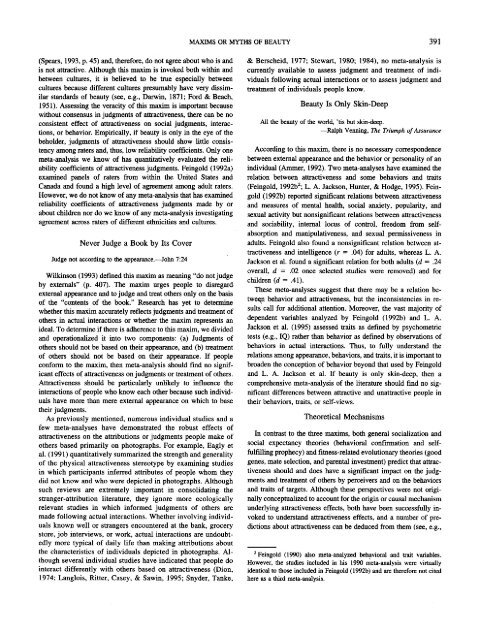


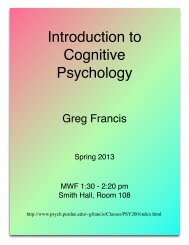
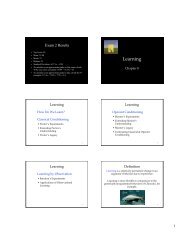
![Exam 4 Study Guide[1]](https://img.yumpu.com/45196739/1/190x245/exam-4-study-guide1.jpg?quality=85)
